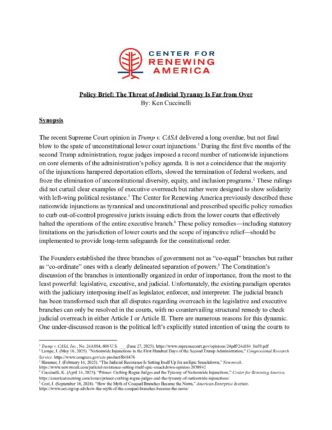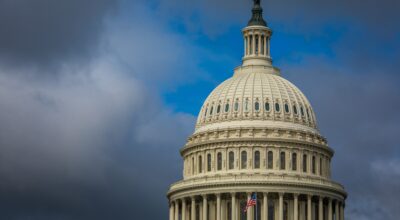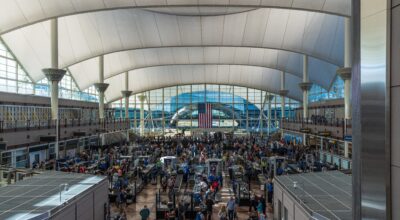
Policy Brief: The Threat of Judicial Tyranny Is Far from Over
Synopsis
The recent Supreme Court opinion in Trump v. CASA delivered a long overdue, but not final blow to the spate of unconstitutional lower court injunctions.1 During the first five months of the second Trump administration, rogue judges imposed a record number of nationwide injunctions on core elements of the administration’s policy agenda. It is not a coincidence that the majority of the injunctions hampered deportation efforts, slowed the termination of federal workers, and froze the elimination of unconstitutional diversity, equity, and inclusion programs.2 These rulings did not curtail clear examples of executive overreach but rather were designed to show solidarity with left-wing political resistance.3 The Center for Renewing America previously described these nationwide injunctions as tyrannical and unconstitutional and prescribed specific policy remedies to curb out-of-control progressive jurists issuing edicts from the lower courts that effectively halted the operations of the entire executive branch.4 These policy remedies—including statutory limitations on the jurisdiction of lower courts and the scope of injunctive relief—should be implemented to provide long-term safeguards for the constitutional order.
The Founders established the three branches of government not as “co-equal” branches but rather as “co-ordinate” ones with a clearly delineated separation of powers.5 The Constitution’s discussion of the branches is intentionally organized in order of importance, from the most to the least powerful: legislative, executive, and judicial. Unfortunately, the existing paradigm operates with the judiciary interposing itself as legislator, enforcer, and interpreter. The judicial branch has been transformed such that all disputes regarding overreach in the legislative and executive branches can only be resolved in the courts, with no countervailing structural remedy to check judicial overreach in either Article I or Article II. There are numerous reasons for this dynamic. One under-discussed reason is the political left’s explicitly stated intention of using the courts to enact policies they otherwise could not pass legislatively, combined with parts of the political right clinging to an over-reliance on originalist judicial philosophy as the remedy for all federal ailments. This has created a paradigm of judicial supremacy within the establishments of both major political parties and ideological movements.
The United States’ system of carefully designed checks and balances is structurally misaligned in large part due to decades of judicial overreach and abuse of power. It will therefore require concerted and sustained efforts throughout the government to repair this system so that the constitutional order is preserved for generations to come. Doing so requires a proper assessment of the history of judicial overreach and judicial restraint.
Background: The Long March of Judicial Supremacy
The preeminence of the judicial branch began with the concept of judicial review, a principle established in Marbury v. Madison (1803) that provides for the Supreme Court to declare a law or action unconstitutional.6 This principle effectively elevated the judiciary as the final authority on legislation and executive actions. There is no commensurate redress available to the other branches outside of a contrary judicial opinion overturning the court’s position, unless Congress and/or the president choose to defy the court’s order.
Chief Justice John Marshall’s original vision for judicial review was far more restrained than the expansive, policymaking role the courts have assumed today. Marshall envisioned a judiciary that would strike down laws only in cases of clear and undeniable conflict with the Constitution, and whose rulings would apply narrowly to the specific parties before the court.7 The modern, pre-CASA dynamic, in which individual judges could unilaterally halt the enforcement of federal laws nationwide, would never have been supported by the Marshall Court.
The first documented instance of a nationwide injunction was in 1963 in Wirtz v. Baldor Electric Company, which determined that Secretary of Labor Willard Wirtz implemented wage determinations for the electric motors industry in an administratively deficient manner.8 The District of Columbia Court of Appeals sided with Baldor and issued a nationwide injunction preventing enforcement of the wage determination for the entire industry, not just the plaintiffs in the case.9 The CASA decision succeeded in curbing such injunctions because they “exceed equitable authority” granted to courts by Congress,10 but the threat of judicial tyranny is far from over because the problem is bigger than just injunctions.
There are three main areas of judicial overreach currently threatening our system of government. Each poses a distinct but significant threat.
1. Issuing Nationwide Injunctions: The most well-known manifestation of judicial tyranny is the explosion of nationwide, or “universal,” injunctions. These orders, issued by a single district judge, prohibit the federal government from enforcing a challenged law, regulation, or policy against anyone in the United States, regardless of whether he or she was a party to the lawsuit. While CASA significantly curbed this abuse of power, lower courts can still attempt workarounds through the emergency docket and class action lawsuits. This practice remains a radical departure from traditional equity, which holds that injunctions should be narrowly tailored to provide relief only to the prevailing parties in a specific case.
2. Legislating from the Bench: Beyond injunctions, Article III has a long-running history of imposing new policies by judicial fiat, particularly through expansive interpretations of constitutional provisions or federal statutes. This “living constitution” philosophy encourages judges to infuse their policy preferences and moral judgments into the law rather than adhering to the original meaning of the text or waiting for legislative action on the subject.
3. Eroding Separation of Powers: A healthy constitutional system requires judicial deference to the policy choices of the elected branches, particularly in areas where the Constitution grants them primary authority or is silent, as noted explicitly in the Tenth Amendment. The judiciary, however, increasingly second-guesses executive decisions and legislative enactments, substituting its judgment for that of policymakers and eroding the separation of powers by exceeding its interpretive mandate. This is particularly evident in areas such as immigration, national security, and administrative law, where judges, often lacking expertise in a given policy area, presume to micromanage complex governmental functions that can entail substantial subjective decision-making.
The infamous decision by District Judge James Boasberg on March 15, 2025, is a prime example of a district judge operating out of his depth and behaving like a party operative instead of a neutral interpreter of the law. Boasberg unconstitutionally halted the Trump administration’s removal of illegal immigrant Venezuelans belonging to the Tren de Aragua gang under the Alien Enemies Act. The Supreme Court slapped Boasberg down just a few weeks later, lifting his injunction while litigation was moved to a different court where the plaintiffs were located.11
These acts of judicial tyranny have wide-ranging and devastating consequences. Among the myriad problems that rogue judges cause are the following:
- Undermining the Rule of Law: Judicial overreach creates a system in which a single judge can effectively veto national policy, rendering the legislative and executive branches subservient to the whims of a single unelected judge in a single district. The “case or controversy” requirement of Article III limits federal judicial power to actual disputes between specific parties. A nationwide injunction extends relief to nonparties, effectively turning the judiciary (and a single judge) into a superlegislative and superexecutive entity that issues decrees for the entire populace.
- Encouraging Forum-Shopping: Activist groups deliberately seek out ideologically sympathetic judges in specific districts, knowing that a single favorable ruling can paralyze an entire federal program or policy. This practice transforms the judicial process into a political lottery, in which outcomes are determined not by law but by geography and judicial temperament. Because of this, the federal government has to win its cases in every district under every district judge at all times, while plaintiffs only need to win in one district.
- Preventing Legal Percolation: The traditional judicial process allows legal issues to “percolate” through multiple courts of appeals, fostering diverse perspectives and allowing the Supreme Court to benefit from a range of reasoned opinions. Nationwide injunctions bypass this crucial process, forcing the Supreme Court to rule on issues without the benefit of a robust, multicircuit analysis.
- Disenfranchising Voters: The ability of a single unelected judge to bring the entire executive branch to a halt transforms any of the roughly seven hundred district court judges into a potential monarch, capable of overriding the president on policies and even personnel decisions. This ability undermines the will of the people and challenges the whole idea of a constitutional republic.
- Creating Unenumerated Rights: Judges “discover” new rights not explicitly mentioned in the Constitution, such as the right to privacy that formed the basis for Roe v. Wade and rights related to social issues that were never contemplated by the Founders. This practice challenges the very framework of America’s system of government, treating God-given rights as if they were created by fallible men and diminishing the role of the amendment process that the Founders so carefully put in place to give the people’s elected representatives responsibility for changing America’s constitutional boundaries.
- Rewriting Statutes: Through imaginative interpretations, judges essentially rewrite federal statutes, substituting their policy preferences for the clear intent of Congress. This undermines the core function of the legislative branch and strips power from the people and their elected representatives.
- Expanding Federal Power: Activist judges often endorse expansive interpretations of federal power, particularly under the Commerce Clause or the Spending Clause, enabling the federal government to intrude into areas traditionally reserved to the states or the people. This practice erodes fundamental rights, preserves unconstitutional statutes, and prioritizes the will of the administrative state over the people’s interests.
The cumulative effect of this overreach is a judiciary that has abandoned its role as a neutral arbiter to resolve disputes and has become a political policymaker by intentionally exceeding its authority to remedy perceived wrongs. This is not judicial review; it is judicial supremacy. These fundamental shifts threaten the very foundation of republican governance, in which the people, through their elected representatives, are sovereign.
The Coming Activist Pivot
CASA significantly curtailed the ability of lower courts to issue nationwide injunctions, delivering a substantial victory for constitutional governance. But the entities that benefit the most from judicial overreach—the entrenched administrative state, the activist legal establishment, and progressive political elites—will not simply concede defeat. The CASA decision will likely channel plaintiffs toward widespread relief through universal class-action lawsuits. The decision also failed to address the issue of third-party standing.12
This means that lower court judges are already finding loopholes and overstepping their authority following the CASA decision.13 An Obama-appointed judge in Massachusetts imposed a temporary restraining order (TRO) on elements of the recently passed reconciliation bill, including the provision defunding Planned Parenthood in the Medicaid program.14 The legislative branch has clear authority to appropriate federal spending, authorize programmatic funding, and implement parameters for such funding, yet Judge Indira Talwani has decided that her court can usurp that authority because “good cause was shown” by the plaintiffs. This is only the first of many new tactics to come:
- Plaintiffs and their activist allies on the bench will focus on class action lawsuits under Rule 23 of the Federal Rules of Civil Procedure. As Justice Samuel Alito stated in his concurrence in CASA, “District courts should not view today’s decision as an invitation to certify nationwide classes without scrupulous adherence to the rigors of Rule 23. Otherwise, the universal injunction will return from the grave under the guise of ‘nationwide class relief.’”15 The likely next iteration of judicial activists’ resistance is precisely that kind of class-action jiu-jitsu. And while such relief has tighter requirements, it is unlikely rogue judges will impose such strict interpretations of Rule 23 requirements until they are forced to do so by a future Supreme Court ruling.
- Plaintiffs and their activist allies on the bench will do precisely what Talwani has done in Massachusetts: exploit emergency dockets and use procedural maneuvers to seek TROs and preliminary injunctions with minimal advance notice to the federal government. Rogue jurists will argue “irreparable harm” to justify immediate, albeit temporary, relief to plaintiffs to create a de facto nationwide injunction through repeated, short-term orders.16 This approach could also result in groups filing multiple requests for TROs in numerous districts to overwhelm federal resources and create a constant drumbeat of opposition on a specific issue.
- Judicial activists will shift their focus to seeking what is called “vacatur” for administrative matters. Under 5 U.S.C. § 706(2)(A), a judge may “set aside” agency action under a variety of circumstances. This is a statutory power, so it is not as abusive as universal injunctions, but activist judges could simply redirect their overreach from their equitable power (i.e., issuing universal injunctions) to their statutory power (i.e., vacating regulations).
The Political Question Doctrine
A core component for restoring the judiciary to its rightful place is the reinvigoration of the political question doctrine. Marbury v. Madison implicitly laid the predicate for this doctrine when Marshall determined that “Questions, in their nature political, or which are, by the constitution and laws, submitted to the executive, can never be made in this court.”17 Ironically, Marbury v. Madison both established the broader principle of judicial review, an animating element of today’s proliferation of judicial supremacy, and included an empowerment of non-justiciability when it comes to inherently discretionary political questions. Thus it remains not just an objectively clever opinion but also the most consequential Supreme Court case in American history.
Two of the most consequential cases for the application of the political question doctrine come from Luther v. Borden (1849) and Georgia v. Stanton (1868).18 In the former, the Supreme Court held that enforcement of the federal government’s Article IV, Section 4 guarantee to preserve a republican form of government for every state is a political question for Congress and not a justiciable issue for the courts.19 In the latter, the Supreme Court held that it did not have jurisdiction over the enforcement of the Reconstruction Acts because the issue at hand was not one of rights or property but rather one concerning the political relationship between the state of Georgia and the federal government.
The phrase “political question” first arose in Baker v. Carr (1962) regarding an equal protection challenge to state legislator apportionment in Tennessee.20 That case laid out six standards or factors for determining whether an issue is non-justiciable as a political question. These include 1) a constitutional barrier for judicial intervention, 2) a lack of discoverable and manageable standards for judicial resolution, 3) a necessity for policy determinations that require nonjudicial discretion, 4) a requirement that independent/judicial resolution infringe on coordinate branches of government, 5) a need for unquestioning adherence to an already established political decision, and 6) the risk of embarrassment from numerous pronouncements being made by various departments and agencies regarding a single question.21
These cases highlight a critical remedy for the judicially-imposed constitutional crisis of rogue judges: self-restraint. The precedent set by the highest court that some issues simply cannot be decided by courts due to their inherently political nature needs to receive far more attention from policymakers in the other branches and adherence by judges across the country.
Other examples of the judiciary using the political question doctrine to limit its own authority include the Supreme Court decision in Coleman v. Miller (1939), which held that the question of whether a state could ratify a constitutional amendment after having previously rejected it, and the timeliness of an amendment’s ratification, were political questions.22 In Goldwater v. Carter (1979), the court dismissed a challenge to President Jimmy Carter’s unilateral termination of a treaty with Taiwan without a clear majority opinion, with Justice William Rehnquist arguing that treaty termination is an inherently political question best left to the executive and legislative branches.23 Nixon v. United States (1993) involved a challenge by a federal judge named Walter Nixon regarding the Senate’s impeachment procedures. The court unanimously held that the Constitution grants the Senate the “sole Power to try all impeachments” under Article I, Section 3, Clause 6, and determined that the issue was a non-justiciable political question.24
More recent examples include Vieth v. Jubelirer (2004), a case regarding partisan gerrymandering claims that did not reach a majority consensus. Justice Antonin Scalia concluded in his plurality opinion that there were no “judicially discernible and manageable standards” for resolving such claims, thereby rendering the issue non-justiciable.25 This opinion was later validated in Rucho v. Common Cause (2019), in which the court definitively held that such claims present non-justiciable political questions, with Chief Justice John Roberts reaffirming Scalia’s opinion that the Constitution commits the regulation of elections primarily to the legislatures in the states and Congress for federal elections.26
Policy Approach: A Revival of Non-Justiciability
The judicial branch operates as the most powerful of the three branches of government, exactly the reverse of the Founders’ vision. This imbalance did not arise overnight, and rectifying it will take sustained efforts from policymakers in both the legislative and executive branches. Critically, restoration of the proper balance within our constitutional order will also require the judicial branch to recognize that self-imposed restraint is essential for preserving the long-term legitimacy of the courts. The growth of a mindset of judicial supremacy has worsened this imbalance.
When the legislative or executive branch is deemed to have overstepped its bounds, the judicial branch is empowered to correct both through the doctrine of judicial review. This principle has arguably transformed the courts into a branch that imposes both general oversight and finality on the two branches of government elected by the American people. Yet, when the judicial branch exceeds its powers, the remedy is far more complicated. In the case of Roe, it took nearly fifty years to elect the right politicians, nominate the right judges, and bring the right case before the right court. This was an admirable effort that ultimately resulted in a salutary moral and constitutional decision, but it must be noted that the remedy only occurred because all parties involved viewed resolution through the prism of judicial supremacy and the finality of the Supreme Court.
In the system originally conceived by the Founders, both the legislative and executive branches would use their various constitutionally prescribed powers to push back on judicial overreach with an understanding that the judicial branch has no right to conduct perpetual oversight of the other two branches while exceeding its authority in the process. In her majority opinion in CASA, Justice Amy Coney Barrett acknowledged this limitation: “Federal courts do not exercise general oversight of the Executive Branch; they resolve cases and controversies consistent with the authority Congress has given them.”27
This understanding of the judicial branch’s limitations should animate all aspects of the federal apparatus and undergird a renewed commitment to move power out of the judiciary to allow for a more robust legislative and executive branch. Barrett’s opinion reflects James Madison’s sentiments in Federalist 47, which aptly describes the present state of the judiciary: “The accumulation of all powers, legislative, executive, and judiciary, in the same hands, whether of one, a few, or many, and whether hereditary, self-appointed, or elected, may justly be pronounced the very definition of tyranny.”28
Each branch of government should propose and implement policies that revive non-justiciability and empower the political question doctrine to extinguish the judiciary-fueled constitutional imbalance in the federal government.
Legislative Remedies to Empower Non-Justiciability
The Constitution grants Congress significant power over the federal judiciary, including the power to establish lower courts, define their jurisdiction, and regulate their procedures. Congress should assert its control and wield its authority decisively. The legitimacy of the legislative branch is derived from the will of the people—a will that is routinely thwarted by rogue judges. Below are policies that Congress should pass to bolster non-justiciability:
- Strip Jurisdiction: This policy is likely the baseline for legislation. Congress should pass legislation that prohibits the courts from having jurisdiction over issues that are clearly political: marriage, border security, and deportation policy, to name just a few. Similarly, the legislation should explicitly strip federal district courts of the ability to issue injunctions beyond the plaintiffs involved in a specific case and outside the geographical boundaries of the district within which that court resides.
- Limit Enforcement Funding: Congress should attach riders to upcoming appropriations bills that prohibit the use of federal funds to enforce or comply with any injunction that extends beyond the plaintiffs to the litigation, reaches outside the boundaries of the district within which a court resides, or exceeds the constitutional authority of the respective court.
- Reform the Administrative Procedure Act: Congress should close off a statutory loophole for future injunctions by reforming the Administrative Procedure Act (APA). The APA governs the judicial review of agency actions. Congress should amend it to clarify that courts can only grant relief to the specific parties before the court and may only review administrative action for clear violations of statutory text or constitutional limits for dispute resolution purposes.
- Attach Non-Justiciable Clauses: Similar to severability clauses, Congress should attach clauses in legislation that specify inherently political questions that bar intervention from the courts. This practice would reassert congressional authority, condition the legislative branch to think often about its ability to check rogue courts, and signal to activist judges that Congress is actively engaging on the issue of judicial overreach.
Executive Remedies to Empower Non-Justiciability
The executive branch, as the primary enforcer of federal law, has a constitutional duty to defend its authority against judicial encroachment. A strong, principled executive should aggressively resist unconstitutional judicial overreach in the following ways:
- Adopt Policies of Non-Acquiescence (Limited Application): In cases where a lower court issues a nationwide injunction that the executive branch believes is unconstitutional or beyond the scope of the court’s authority, the president should adopt a policy of non-acquiescence outside the jurisdiction of the issuing court while still complying within that specific jurisdiction and concerning the specific party receiving injunctive relief. This would signal the executive branch’s disagreement with the overreach, move the debate back to an argument over standing and injunctive relief, preserve existing constitutional guardrails, and allow for continued appellate review.
- Preempt Activist Judges: The president should attach executive authority statements in key executive orders, actions, proclamations, and other related documents that assert the constitutional purview of the executive branch while explicitly rebuffing attempts by courts to rule on inherently political questions. Further, the president should include “response guidelines” for federal agencies that instruct them to only adhere to injunctions within the issuing district and concerning specific plaintiffs, and—in the event of a non-justiciable challenge to the federal government—to operate as instructed until and unless the Supreme Court rules otherwise.
- Prioritize Non-Justiciable Appeals: The Department of Justice should adopt aggressive and proactive litigation strategies that challenge lower court rulings believed to be non-justiciable. This effort may require the creation of a new office within the department that proactively identifies and challenges cases on non-justiciable grounds to preempt judicial overreach in inherently political matters. Such aggression would signal to activist judges and activist organizations that the executive branch is not playing defense and allowing rogue courts to continue to abuse their power.
- Use Pardon Power Strategically: If a federal official is held in contempt for refusing to comply with an unconstitutional nationwide injunction or holding to the executive branch’s view that the matter is non-justiciable and therefore should be ignored, the president should use his pardon power to protect the officials in jeopardy. This action would signal to the courts that their usurpation of authority is being challenged to the fullest extent possible.
Judicial Remedies to Empower Non-Justiciability
The judiciary is exceeding its authority and fueling a constitutional crisis due to activist judges and a prevailing sentiment of judicial supremacy within the broader body politic. The long-term legitimacy of the courts requires self-restraint. While originalist judges are far and away more likely than activist progressive judges to exercise such restraint, promoting restraint will likely require more aggressive directives from the Supreme Court, including the following efforts:
- Closing CASA Loopholes: The Supreme Court will likely need to ensure that lower courts do not abuse Rule 23 of the Federal Rules of Civil Procedure to revive nationwide injunctions through class-action lawsuits. As Alito warned, this approach poses a real threat to the constitutional order reestablished in CASA.
- Supporting Non-Justiciable Validation: The Supreme Court, appellate courts, and district courts must reinvigorate self-restraint when it comes to ascertaining whether or not an issue is an inherently political question that operates outside the constitutional scope of Article III. Just as adherence to originalism became the gold standard for future judges on the political right, support for an expanded embrace of non-justiciability over political issues should be the quality that constitutionalists seek among new jurists.
The judiciary has moved from interpreting the law to making the law, from resolving specific disputes to dictating national policy, and from respecting the separation of powers to encroaching upon the prerogatives of the other branches. This long march of judicial usurpation has brought us to the current crisis, in which lower courts feel entitled to issue sweeping injunctions and edicts that paralyze the executive branch and undermine the very concept of democratic governance.
If the courts are unable to impose self-restraint on their constitutional excesses, then the legislative and executive branches will have little choice but to do it for them. The legitimacy of the courts is at stake, as is the functionality of our republic.
Conclusion
The Supreme Court’s decision in CASA is a welcome development. But it does not offer the finality needed to restore the constitutional order from progressive activists masquerading as judges.
The current state of judicial overreach, particularly the unchecked proliferation of nationwide injunctions and the courts’ intrusion into inherently political questions, represents a profound challenge to the constitutional order of the United States. It is a crisis born of a judiciary that has strayed far from its original mandate, embracing a role as a national policymaker rather than a neutral arbiter of law.
This policy brief is not an attack on the judiciary’s legitimate role, but a necessary defense of the Constitution itself. Efforts to reform the judicial branch are about ensuring that the American people remain sovereign and that no unelected branch of government can unilaterally dictate the nation’s destiny. The future of our republic depends on our willingness to confront this crisis head-on and restore the balance of powers enshrined by our Founders. It will require a concerted and sustained campaign from all three branches of government (especially the legislative and executive branches) to put the judiciary back in its constitutionally delineated box.
Endnotes
1. Trump v. CASA, Inc., No. 24A884, 606 U.S. ___ (June 27, 2025); https://www.supremecourt.gov/opinions/24pdf/24a884_8n59.pdf
2. Lampe, J. (May 16, 2025). “Nationwide Injunctions in the First Hundred Days of the Second Trump Administration,” Congressional Research Service. https://www.congress.gov/crs-product/R48476
3. Hammer, J. (February 14, 2025). “The Judicial Resistance Is Setting Itself Up for an Epic Smackdown,” Newsweek. https://www.newsweek.com/judicial-resistance-setting-itself-epic-smackdown-opinion-2030942
4. Cuccinelli, K. (April 14, 2025). “Primer: Curbing Rogue Judges and the Tyranny of Nationwide Injunctions,” Center for Renewing America. https://americarenewing.com/issues/primer-curbing-rogue-judges-and-the-tyranny-of-nationwide-injunctions/
5. Cost, J. (September 16, 2024). “How the Myth of Coequal Branches Became the Norm,” American Enterprise Institute. https://www.aei.org/op-eds/how-the-myth-of-the-coequal-branches-became-the-norm/
6. Milestone Documents (Accessed July 7, 2024). “Marbury v. Madison (1803),” The National Archives. https://www.archives.gov/milestone-documents/marbury-v-madison
7. Engdahl, D. (1992). “John Marshall’s ‘Jeffersonian’ Concept of Judicial Review,” Duke Law Review. https://scholarship.law.duke.edu/cgi/viewcontent.cgi?article=3202&context=dlj
8. Shelton, A. (January 28, 2020). “The Supreme Court & Universal Injunctions,” Institute for Justice. https://ij.org/cje-post/the-supreme-court-universal-injunctions/
9. Ibid.
10. Trump v. CASA, Inc., No. 24A884, 606 U.S. ___ (June 27, 2025); https://www.supremecourt.gov/opinions/24pdf/24a884_8n59.pdf
11. Hurley, L. and Grumbach, G. (April 7, 2025). “Supreme Court Gives Boost to Trump Administration’s Deportation Plans Under Alien Enemies Act,” NBC News. https://www.nbcnews.com/politics/supreme-court/supreme-court-gives-boost-trump-deportation-plans-alien-enemies-act-rcna198585
12. See Justice Alito, Concurring Opinion (June 27, 2025). “Trump v. CASA Inc.,” Supreme Court of the United States. https://www.supremecourt.gov/opinions/24pdf/24a884_8n59.pdf
13. Weingarten, B. (July 7, 2025). “SCOTUS Ruling Against Universal Injunctions Didn’t Go Far Enough,” The Federalist. https://thefederalist.com/2025/07/07/scotus-ruling-against-universal-injunctions-didnt-go-far-enough/
14. Judge Talwani (July 7, 2025). Planned Parenthood v. Kennedy. United States District Court of Massachusetts. https://storage.courtlistener.com/recap/gov.uscourts.mad.286600/gov.uscourts.mad.286600.18.0.pdf. This ruling was followed on July 21, 2025 by the entry of a preliminary injunction.
15. Justice Alito, Concurring Opinion (June 27, 2025). “Trump v. CASA Inc.,” Supreme Court of the United States. https://www.supremecourt.gov/opinions/24pdf/24a884_8n59.pdf
16. Every day that Talwani keeps the federal spigot open for Planned Parenthood is worth approximately $2 million to Planned Parenthood, and that same amount is lost to the taxpayers.
17. Marbury v. Madison, 5 U.S. 137 (1803)
18. Luther v. Borden, 48 U.S. 1 (1849); Georgia v. Stanton, 73 U.S. 50 (1868)
19. See also CRA Staff (January 10, 2022). “The Federal Government’s Guarantee to Protect the States Against Invasion,” Center for Renewing America. https://americarenewing.com/issues/the-federal-governments-guarantee-to-protect-the-states-against-invasion/
20. Baker v. Carr, 369 U.S. 186 (1962)
21. Id at 217
22. Coleman v. Miller, 307 U.S. 433 (1939)
23. Goldwater v. Carter, 444 U.S. 996 (1979)
24. Nixon v. United States, 506 U.S. 224 (1993)
25. Vieth v. Jubilerer, 541 U.S. 267 (2004)
26. Rucho v. Common Cause, 588 U.S. 684 (2019)
27. Justice Barrett, Majority Opinion (June 27, 2025). “Trump v. CASA Inc.,” Supreme Court of the United States. https://www.supremecourt.gov/opinions/24pdf/24a884_8n59.pdf
28. Madison, J. (1788). Federalist 47. The Federalist Papers. https://avalon.law.yale.edu/18th_century/fed47.asp





